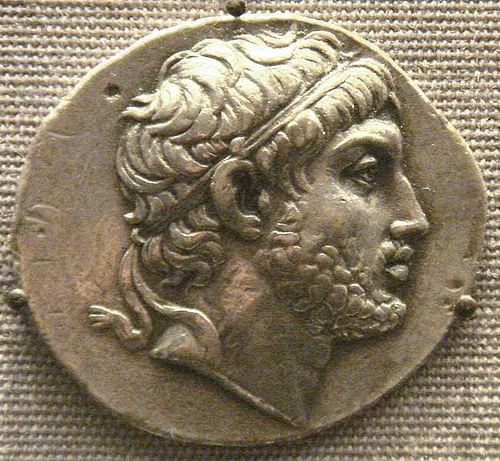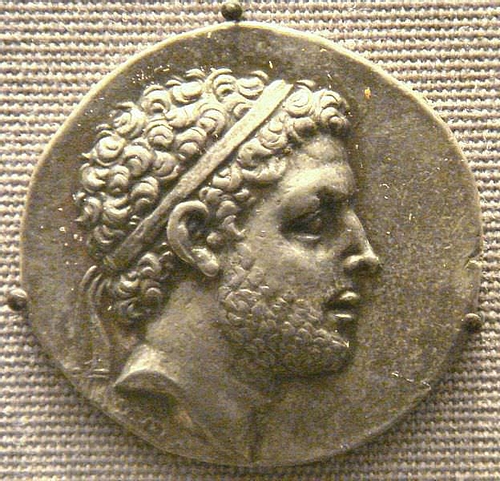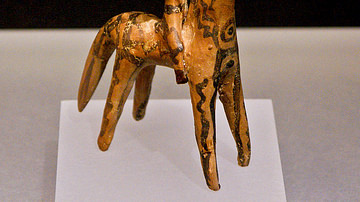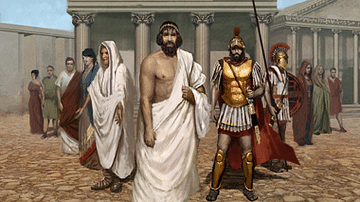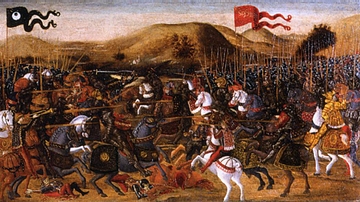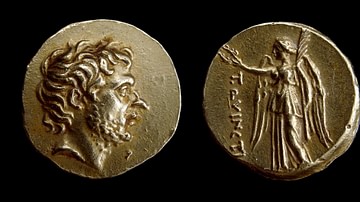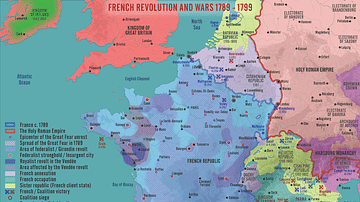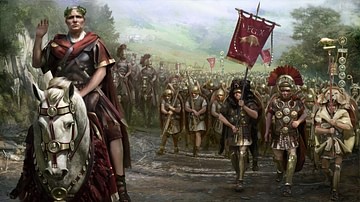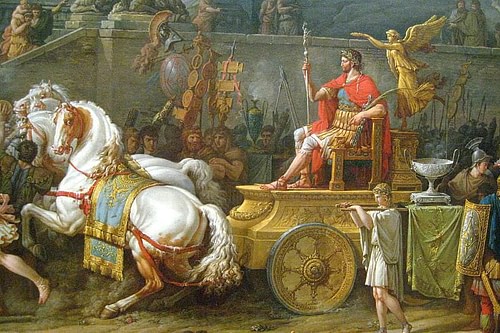
The Battle of Pydna in June 168 BCE was a decisive Roman victory that ended the Third Macedonian War and established Rome as the dominant power in the Mediterranean. The Roman Republic was expanding, enlarging its sphere of influence along the Adriatic, so when several of the southern Greek city-states appealed to them to ward off the advances of Philip V of Macedon, they entered into the fray, commencing a series of what became known to history as the Macedonian Wars. In June of 168 BCE, the Roman general Lucius Aemilius Paullus entered into battle against Philip's successor and son Perseus near Pydna, a city in northeastern Greece. The resulting fight would spell the end of an empire established by Philip II and his son Alexander the Great.
The First Macedonian War Ends & the Second Begins
This final meeting between the Macedonians and Romans came after a long period of conflict beginning around 215 BCE. It would be the last opportunity to answer the question of which was better: the phalanx of Macedon or the legions of Rome. The Romans had first become involved in Greece when Hannibal Barca of Carthage, already at war with Rome in the Second Punic War (218-201 BCE), entered into an alliance with Philip V of Macedon. Fearing the consequences of this union, the Greek city-states appealed to Rome - an ally of Illyria - and together they prevented Philip from conquering the peninsula. While the alliance with Hannibal had initially proven to be a distraction to Rome, it did not deter them from the conflict in Greece. An uneasy peace was reached, bringing an end to the First Macedonian War. Unfortunately for both Rome and Greece, Philip could not stay idle for long and rekindled his desire to conquer all Greece, initiating the Second Macedonian War. In 200 BCE, he made another alliance, this time with Antiochus III, the king of the Seleucid Empire (Syria), which was a part of Alexander's old empire.
In 197 BCE the Romans proved victorious over Philip's forces at Cynoscephalae where he lost over 13,000 men. Philip realized he could not win against a superior army and abandoned his plans. In 194 BCE the Romans returned home, and for a short time, Greece was declared free. In 190 BCE King Antiochus, who had expanded his empire into Asia Minor and the Balkans, finally ended his fight with Rome after a disastrous defeat in the Battle of Magnesia at the hands of Scipio Africanus (the same man who had defeated Hannibal at the Battle of Zama in the Second Punic War). His conquered lands were returned. Ironically, Philip, despite his earlier alliance, actually aided Rome against Antiochus. Although Rome had never entered the wars to gain land, many of the Greek city-states became obligated to Rome.
The Legion or the Phalanx?
Throughout these battles in Greece, the Romans remained confident, believing that their superior training, coupled with the flexibility and speed of Roman warfare, would bring them success. To the Romans, the victories against Philip and Antiochus were primarily due to the superiority of the Roman army, which demonstrated itself to be far more adaptable than that of their enemy. These were victories of the Roman legion over the Greek phalanx; victories of the double-edged gladius (Roman short sword) over the 18-foot sarissa (Macedonian spear).
History had long shown the strength of the phalanx, a formation that had led to the conquest of Persia decades before, and a formation advanced by Phillip II and his son Alexander. In the 4th century BCE, the Macedonians possessed an army with vastly improved weaponry and overall tactical ability that forged an empire that encompassed much of the known world, but it was also a formation dependent primarily on cohesion; it could be ineffective if otherwise. While the phalanx had proved valuable to the Macedonian army earlier, the victories at the Battle of Issus and at the Battle of Gaugamela were in the past. The Romans had recognized one of the few faults with the phalanx: it was vulnerable to both flank and rear attacks. This fault would eventually bring about the defeat of the Macedonians and their supremacy over Greece.
Although the phalanx had been successful against Darius III and the Persians, the Romans proved to be a different matter, but this final battle at Pydna was not the first meeting between the legion and phalanx. Initially, the phalanx proved to be a worthy and effective opponent. In 280 BCE, as Rome expanded its domain on the Italian boot, the city of Tarentum appealed to Pyrrhus, the King of Molossis (cousin of Alexander), for help. The Romans were quickly defeated by Pyrrhus, his army, and his elephants at the Battle of Heraclea. The following year the two armies met again at Asculum, and again, Pyrrhus and his army of over 40,000 routed the Romans, despite significant losses, which was a Pyrrhic victory. In 276 BCE, the third and final meeting between the two forces (Carthage also joined the battle on the side of Rome) at Beneventum (a city near Naples) saw the Romans victorious.
Under the leadership of Philip V and his son Perseus, Macedon was in decline; it was no longer the dominant force it had been under Alexander and his successors. The army had changed little. The Macedonian soldier still carried the traditional sarissa, the xiphos, a shorter sword for close-in-hand fighting, and a shield hanging from his left shoulder; his two hands remained free to carry the long 18-foot pike. As in the past, the phalanx functioned well on clear, even ground, but it could only fight in one direction, as it needed lighter troops on the flanks to protect the sides. To be fair, there are those who dispute this idea, pointing to Alexander's victory at Gaugamela. On the other hand, the Roman legions proved to be far more flexible, relying on tactical maneuvers to defeat their enemies, and as demonstrated at Pydna, could function on any terrain. Like the phalanx, the Roman legion was well-organized. Generally numbering about 5,000 men, it was divided into maniples: each maniple was composed of two centuries (about 80-100 men). Besides the short sword or gladius, the Roman soldier carried a javelin or pilum and shield or scutum.
Perseus Succeeds Philip V
In 179 BCE Philip V died, succeeded by his son Perseus, who, like Alexander before him, chose to continue his father's dream. Some claim the new king quickly disposed of his pro-Roman brother. In 172 BCE war erupted between Eumenes of Pergamon and Perseus; Eumenes had begun acquiring territory in both Asia Minor and the Balkans. This expansion caused considerable concern for both Rome and Macedon. Perseus further angered the Romans when he made an alliance with a number of Germanic tribes, Rome's enemies to the north. Deciding that Perseus posed the bigger threat, the Romans entered the fray on the side of Eumenes. Unfortunately for the Romans, Perseus defeated them in three separate battles (171-170 BCE). Perseus, however, failed to follow his victories with any further assault on Roman forces. Instead, he positioned himself in a more defensive measure, possibly giving Rome more respect than they deserved at that time. In 168 BCE the Senate took the initiative to appoint someone new to lead the Roman forces against Perseus. He was the recently-named consul Lucius Aemilius Paullus, a 60-year-old veteran of battles in Spain and Liguria and the brother-in-law of Scipio Africanus.
Perseus & Paullus Meet
In June 168 BCE Paullus finally met Perseus in battle. After arriving in Greece, Paullus had taken the time to retrain his exhausted army well, an army that was in serious need of discipline. With the Roman fleet stationed in the Gulf of Thessalonika, serving as a decoy, possibly to cut off the Macedonian supply line, the Roman army reached the Elpeus River where Paullus planned to attack Perseus's camp. Using locals as guides, he sent a small force along a path at the base of Mt. Olympus, hoping to flank Perseus from the northwest. Learning of this plan, Perseus chose not to fight and quickly broke camp, fleeing southward.
Paullus had no intention of letting the Macedonian king escape; he regrouped his men at Diem, and followed Perseus, catching up with him outside Pydna, a city located on the Leucus River. Paullus set up his camp at the foothills of Mt. Olocrus, overlooking the Macedonian encampment. He had 25,000 thousand infantry (together with 34 elephants), while Perseus had 40,000 infantry and 4,000 cavalry (no elephants). At this time Perseus could have defeated the Romans without a battle; he could have easily prevented the Roman supply lines from reaching them, thereby starving them out. Instead, both sides prepared to do battle.
On the night of 21 June 168 BCE there was a lunar eclipse that had been predicted by one of the Roman soldiers. It was a sign that the gods favored the Romans. To honor the gods, Paullus made a sacrifice of oxen and heifers. The Macedonians interpreted the eclipse quite differently; they shouted at the moon to return; to them, it was a sign of evil which foretold their defeat. Early the next day, a short truce was declared, enabling both sides to get water from a short stream that ran between the two armies; shortly, however, it came time for battle. One story tells of a bolting horse (some say mule) initiating the fight. Perseus and his men immediately went on the offensive, crossing the river. He had two phalanxes in the center, mercenaries on the left, and cavalry on the right. Paullus positioned his men at the foot of the mountain, with his elephants in the rear and cavalry on the left, Latium allies on the right, and two legions in the center.
The End of the Battle of Pydna
The battle only lasted about an hour. There was some early Macedonian success; the Romans began pulling back, but this initial success soon waned as Perseus's army marched onto broken ground and slowed, creating a gap. Paullus went on the offensive. He sent his elephants to attack Perseus' left flank, which immediately collapsed, and ordered his legions to enter the gap and, as with Darius at Gaugamela, this proved to be advantageous for the Romans and their short swords; it became an attack from within. The Macedonians were forced to throw down their sarissas and use their xiphos, and a one-on-one, hand-to-hand, fight began. Seeing that defeat was imminent, Perseus fled, taking his cavalry with him, first to his capital of Pella and then to the island of Samothrace (losing much of their treasure to an unscrupulous sea captain).
The Romans slaughtered the remaining Macedonians: over 20,000 were dead and 6,000 taken prisoner (5,000 more were on the run). Rome lost only 100 with 400 wounded. Perseus was pursued and captured after the Romans circled the island. He was taken to Rome where he was paraded through the streets; a total humiliation for him but a symbol of victory for the Romans. Pydna was plundered and looted and the countryside ravaged. The rest of Greece was not safe as the Romans then overran both Athens and Corinth.
Thus ended the Third Macedonian War. Macedon was, at last, defeated. Throughout the previous wars, Rome had made no territorial gains, but after the Battle of Pydna their luck and policy both changed. The Roman Senate chose to occupy Greece and Macedon. Rome now controlled the Adriatic. The Macedonians were no longer a threat. While Greek culture may have conquered Rome, the Roman Republic and, later, the Roman Empire, conquered the Greeks and dominated the Mediterranean Sea for the next few centuries.
